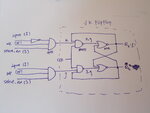kongruxue
Newbie level 6
Hi, I want to get the gate circuit which shows in the handwrite gate circuit
 .
.
so I wrote the VHDL code below
and I check the RTL Viewer, I get the image

but not the same, How do I change the code?
 .
. so I wrote the VHDL code below
Code:
LIBRARY ieee;
USE ieee.std_logic_1164.ALL;
USE ieee.numeric_std.ALL;
ENTITY memory_cell IS
PORT
( I :IN std_logic;----input bit
W :IN std_logic;-----write_enable
S :IN std_logic;----select_enable
clk :IN std_logic;
q :OUT std_logic------output bit
);
END memory_cell;
ARCHITECTURE structural OF memory_cell IS
SIGNAL J,K,J_g,K_g,Qa,Qb :std_logic;
ATTRIBUTE keep : boolean;
ATTRIBUTE keep OF J_g,K_g,Qa,Qb: SIGNAL IS true;
BEGIN
K <= NOT I AND W AND S;
J <= I AND W AND S;
K_g <= NOT (K AND clk AND Qa);
J_g <= NOT (J AND clk AND Qb);
Qa <= K_g NOR Qb;
Qb <= J_g NOR Qa;
q <= Qa;
END structural;and I check the RTL Viewer, I get the image

but not the same, How do I change the code?